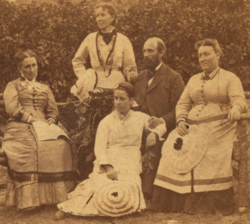Poland Act
Pub. L. 43–469 | |
| Statutes at Large | 18 Stat. 253 |
|---|---|
| Legislative history | |
| |
| Mormonism and polygamy |
|---|
 |
|
Latter Day Saints portal |
The Poland Act (18 Stat. 253) of 1874 was an act of the
Background
In 1862,
In the following years, several bills aimed at strengthening the anti-bigamy laws failed to pass the
Frank J. Cannon stated: "Brigham had no trouble in organizing at home a resistance to the Cullom bill, in which Gentiles, Godbeites, and orthodox Mormons stood side by side. The women of Utah made a special and particular protest. The fact that women in the state of Utah had the right to vote in 1870--one of only two places in the entire United States where women could vote at that time[3]--gave the protests added weight and consideration. The influence of railroad and telegraph friends was also called upon to resist the bill. Whether more tangible means of persuasion were used cannot be affirmed though some of Brigham's allies and protectors of that day were no more above susceptibility to financial influence than Brigham was above using it. At any rate, the Cullom bill died of willful neglect, and the territory was free, for a time, from this direct and dangerous menace to its independence."[4]
Immediate effects
Under the Poland Act, jury lists were to be drawn by the district court clerk (then a non-Mormon) and the
After
In 1875, Reynolds was convicted and sentenced to two years of
See also
- Utah War (1857–1858)
- Edmunds Act (1882)
- Edmunds-Tucker Act(1887)
- LDS Church v. United States(1890)
- 1890 Manifesto
- Smoot Hearings(1903–1907)
- Second Manifesto (1904)
- The Church of Jesus Christ of Latter-day Saints and politics in the United States
- Timeline of civil marriage in the United States
- U.S. District Attorney for the Utah Territory1878–1884 based on this act
References
- Utah State University Press, 1989),p. 244
- Deseret Book Co., 1974), p. 444
- ^ White, Jean Bickmore (Fall 1974). "Women's Suffrage in Utah". Utah History to Go. Utah.gov. Archived from the original on 23 November 2012. Retrieved 15 April 2016.
- ^ Frank J. Cannon and George L. Knapp, Brigham Young and his Mormon Empire, 1913, p.[page needed] [full citation needed]
- ^ Larson, "Government, Politics, and Conflict," pp. 252, 254.
- ^ Bruce A. Van Orden, "George Reynolds: Secretary, Sacrificial Lamb, and Seventy," Ph.D. diss., Brigham Young University, 1986, pp. 53, 57–62, 71, 76–77, 80–86, 103, 108
Sources
- Stephen Eliot Smith, "The 'Mormon Question' Revisited: Anti-polygamy Laws and the Free Exercise Clause" (2005) (LL.M. thesis, Harvard Law School).
External links
- Poland Act of 1874 Relating to the Courts of Utah
- "43rd U.S. Congress, 1st Session, Volume 18, Part 3, Pages 253-256". A Century of Lawmaking for a New Nation: U.S. Congressional Documents and Debates, 1774 - 1875. The Library of Congress. June 23, 1874.
- Peters, Gerhard; Woolley, John T. "Ulysses S. Grant: "Special Message," February 14, 1873". The American Presidency Project. University of California - Santa Barbara.
